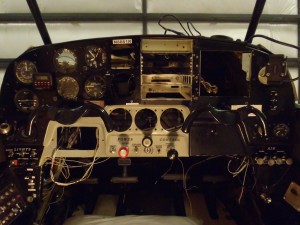So what might end up being the world’s largest annual has begun. Thankfully, the IA (aircraft mechanic) who works on my airplane is great about letting me do a bunch of the labor. Thankfully, I enjoy working on the airplane, but I do tend to spend a lot of time in the hangar during annual inspection season. This year, I’m trying to catch up on a number of little things:
- Recovering the flaps and ailerons. The flaps take a lot of abuse because they sit so close to the ground during landing. One of the ailerons was slightly twisted, likely because someone wasn’t careful during the fabric shrink last time they were recovered, so fixing that should help in getting the airplane close to rigged correctly.
- Sending the hydraulic powerpack (the thing that makes the gear and flaps go up and down) out for overhaul. It was seeping a little bit of hydraulic fluid out of the flap pressure adjustment, so it was time to send it out. Unfortunately, getting it out from under the front seats is a bit of a pain since it just barely fit in the first place.
- Installing the service kits for a couple of old service letters that raised the fuel drains flush with the bottom of the airplane so that they wouldn’t get ripped off in the event of a gear up landing.
- Replacing all the engine gauges (which needed overhaul) with a JPI EDM-900, which will free up some much needed panel space and give me exhaust gas and cylinder head temps for all 6 cylinders. The EDM-900 also gives fuel flow and fuel totalizer, meaning that I’ll be able to be much more precise in fuel management.
- With the engine gauges by the left seat pilot removed, there’s space for the autopilot out of the way so that radio bay where it lives now is available for, well, radios. At the same time, since I had to remove a bunch of wiring to get the EDM-900 installed (and the old stuff out), I’m going to wire the nav input for the autopilot to include a selector for both nav radios. When we installed the radios a couple years ago, we only wired the autopilot to the VAL nav unit because the other unit was a King KX-145, which wouldn’t drive the autopilot. It’s since been replaced with a Narco Mk-12D, which is both a better receiver than the VAL and can drive the autopilot. So more wiring fun…
- Since I’ve got most of the wiring bundles ripped apart to clean up the EDM-900, I’m also taking this opportunity to replace the 53 year old circuit breakers with modern breakers. In addition to being calibrated properly, they’ll all be pullable so equipment can be disabled in flight. The main bus was a poor design, so that will get updated as well. Once it’s done, the main bus should be able to handle 60 amps (it was originally designed for 35 amps) when I replace the generator with an alternator in the future.
- If we’re not horribly behind come April (when I hope to do the annual inspection), I’m also going to try to deal with the fact that the horizontal stabilizer and elevators aren’t quite rigged correctly.
Obviously, quite a list. I started a couple weeks ago with the removal of the flaps and ailerons. They’ve now been stripped of fabric, sanded, repaired (the trailing edge of one of the flaps had some corrosion), and now varnished. I still have a coat of varnish to apply, hopefully on Wednesday. This weekend will start the actual covering process. Hopefully I’ll be able to get the fabric glued down and the first shrink done so that I can start stitching the following weekend.
On the EDM front, the panel’s stripped as far as needed and I’ve started pulling the wires that are no longer needed. The alarm light is installed, just so that I could claim I’ve installed something :). I’ve generally figured out where I’m going to put all the sensors and wire bundles, but it’s going to take a little while to get everything in place. Currently, the panel looks a little rough:
